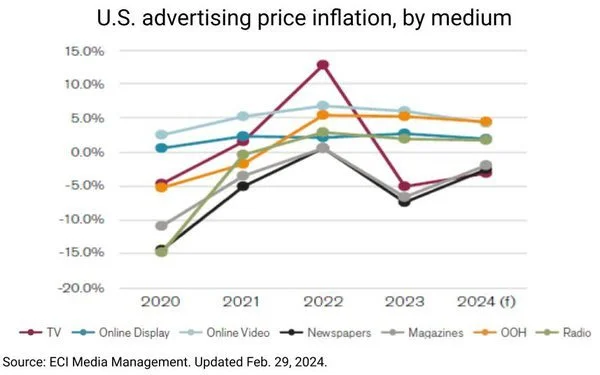Ad Price Inflation Slows Down, TV Remains Deflationary
A line graph showing U.S. advertising price inflation trends by medium from 2020 to 2024.
As the U.S. grapples with consumer price inflation, the media industry faces its own set of dynamics. Advertisers, planners, and buyers are navigating shifting costs, particularly in the realms of TV and “print” media. Let’s delve into the latest insights from ECI Media Management’s first quarter media price inflation estimates.
TV Ad Costs: A Deflationary Trend
While TV ad costs remain submerged, there’s a glimmer of improvement. The erosion of TV ad pricing power has shifted from a steep -5.1% in 2023 to a more manageable -3.1% this year, according to ECI’s tracking. The industry breathes a sigh of relief as last year’s Hollywood strikes fade into memory.
The Broader Media Landscape
1. Digital Dominance
Digital media continues to drive change. As consumers shift their attention online, advertisers follow suit. The allure of targeted ads, real-time analytics, and personalized content propels digital spending. Whether it’s social media campaigns, programmatic advertising, or influencer collaborations, the digital realm remains a force to be reckoned with.
2. Out-of-Home (OOH) Resurgence
Billboards, transit ads, and interactive displays—OOH media is making a comeback. With people venturing outdoors again, advertisers seize the opportunity to engage audiences beyond screens. Creative OOH placements in urban centers and high-traffic areas capture attention and create lasting impressions.
3. Radio’s Steady Climb
Radio, often considered a veteran medium, quietly adapts. While TV and print face headwinds, radio inches upward. Why? Local relevance, loyal listenership, and the ability to reach specific demographics. Advertisers recognize its enduring value, especially in regional markets.
Economic Uncertainty and Caution
ECI Global CEO Fredrik Kinge offers a sobering perspective: “In the United States, stubborn economic uncertainty and high costs prevail.” As we navigate the first half of 2024, caution prevails. Here’s what to expect:
Flat Advertising Budgets: Companies tread carefully, scrutinizing operational expenses. Advertising budgets remain steady or may experience slight declines.
Cost Containment and Efficiency: The focus shifts to optimizing resources. Efficiency gains and data-driven strategies take center stage.
Data-Driven Channels: Advertisers pivot toward channels that yield measurable results. Data informs decisions, ensuring every dollar spent counts.
Conclusion
While 2024 may not be the robust year economists envisioned, adaptability and strategic choices will define success. As the media landscape evolves, advertisers must balance innovation with fiscal responsibility. The journey continues, guided by the pulse of consumer behavior and the promise of effective communication.

